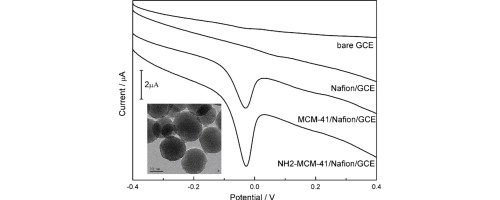,
a College of Chemistry, Chemical Engineering and Materials Science, Soochow University, Suzhou, Jiangsu, 215123, PR China
b The Key Lab of Health Chemistry and Molecular Diagnosis of Suzhou, PR China
c Department of Quartermaster Engineering, Jilin University, No. 5333, Xi'an Road, Changchun 130062, PR China
Anal. Chim. Acta. 2014, 848, 25-31
This paper described a facile and direct electrochemical method for the determination of ultra-trace Cu2+ by employing amino-functionalized mesoporous silica (NH2-MCM-41) as enhanced sensing platform. NH2-MCM-41 was prepared by using a post-grafting process and characterized by X-ray diffraction (XRD), transmission electron microscopy (TEM) and fourier transform infrared (FTIR) spectroscopy. NH2-MCM-41 modified glassy carbon (GC) electrode showed higher sensitivity for anodic stripping voltammetric (ASV) detection of Cu2+ than that of MCM-41 modified one. The high sensitivity was attributed to synergistic effect between MCM-41 and amino-group, in which the high surface area and special mesoporous morphology of MCM-41 can cause strong physical absorption, and amino-groups are able to chelate copper ions. Some important parameters influencing the sensor response were optimized. Under optimum experimental conditions the sensor linearly responded to Cu2+ concentration in the range from 5 to 1000 ng L−1 with a detection limit of 0.9 ng L−1 (S/N = 3). Moreover, the sensor possessed good stability and electrode renewability. In the end, the proposed sensor was applied for determining Cu2+ in real samples and the accuracy of the results were comparable to those obtained by inductively coupled plasma optical emission spectrometry (ICP-OES) method.

链接:
//www.sciencedirect.com/science/article/pii/S0003267014009490